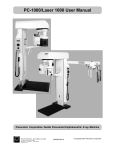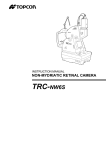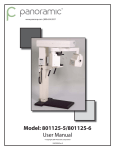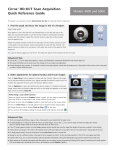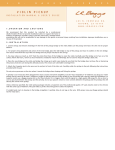Download 513-300-152_rA User Guide, Classic Series Violin.indd
Transcript
USER GUIDE V-100 / V-200 Welcome Thank you for making Fishman a part of your acoustic experience. We are proud to offer you the finest acoustic amplification products available: high-quality professional-grade tools which empower you to sound your very best. Troubleshooting If you are unfamiliar with this product, please pay close attention to the requirements for installation. Failure to do so can result in permanent damage to the pickup. Installation by a qualified professional is strongly recommended. Technical support, troubleshooting tips and installation information can be found at http://www.fishman.com/support/ 2 Installation 1. Measure the opening of the wing slot on the bridge with a vernier caliper. The opening should be between .060” and .090” (1.5mm and 2.3mm) for proper fit. If the wing slot measures less than .060” (1.5mm), employ a qualified repairman to enlarge the wing slot. If the wing slot measures more than .090” (2.3mm), as is the case in violas, a small wooden shim may be required. If so, use an adhesive to bond the shim to the “leg” face. 3 2. Slide the V-100 Transducer into the wing slot of the bridge. Make certain that the sensing element is in contact with the wing face and that the spring is in contact with the corresponding “leg” face of the bridge. The spring (made of tempered beryllium copper) provides the proper tension for a snug fit in wing slots ranging from .060” to .090” (1.2mm to 2.3mm). Note: For best performance, the wing slot opening should be exactly .070” (1.8mm). 4 3. Jack installation: For V-100: Once the transducer is properly installed in the bridge, attach the output jack to the tailpiece with the black plastic tie wrap. For V-200: After fitting the pickup to the violin, locate the jack to the left of the chinrest on your violin and tighten it with the enclosed chinrest key. Be careful not to scratch the side of your violin. 5 Fine Tuning Once the pickup is properly mounted, plug the instrument into an amplifier and play at a low volume. Carefully shift the pickup a small distance within the slot and test using the trial and error method, listening for the the best location. Note: If installation is to be permanent, a small drop of adhesive on the side (lower face) of the transducer can be used. 6 Plugging In An impedance matching preamp is recommended, but not required. This will help realize the full frequency response potential of the pickup and allow for cable runs longer than 10 feet without signal deterioration. Use a high quality, low capacitance ¼” shielded instrument cable. This will ensure minimal tone coloration and hum. 7 WWW.FISHMAN.COM 513-300-154 Rev A 4-09








